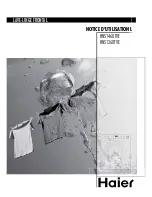
1
Cleaning the Water suction filter (Fig.44)
(When used as self-priming)
1. Remove the filter cap () and remove the filter (1)
from the filter case (26).
2. Rinse accumulated debris away from the filter mesh.
3. Return the filter to the filter case and attach the filter cap.
WARNING!
• Be careful not to lose the rubber washers (3) located
on the inside and top portion of the filter cap.
• Ensure that the filter unit is correctly inserted into the
filter case before attaching the filter cap. (The inserted
filter unit should not extend beyond the filter case
opening). Hold the filter case parallel with the cap
above, and thread the cap directly onto the filter case. If
the filter is not inserted correctly, leakage or low spray
pressure may occur.
• A clogged filter may cause low spray pressure.
Replace the pump oil (Fig.45, 46)
WARNING!
As the pump and pump oil are hot immediately after
operation, there is a danger of getting burnt. Replace the
oil after cooling sufficiently.
- The device is shipped with pump oil in it.
- Use the following as a guide for the frequency to replace
the oil.
First time --- 30 hours
Subsequent times --- 300 hours
- Use the supplied oil to replace the first time,
and purchase Ryobi genuine oil for subsequent
replacements.
(How to replace)
WARNING!
Do not top up with oil. If the appropriate volume (100 ml) is
exceeded, it may cause a malfunction.
1. Tilt the main unit backwards, and remove the oil cap
(3) after loosening it with a coin, etc.
WARNING!
If the oil cap is removed with the main unit
upright, oil may flow out of the oil inlet.
. Attach the oil nozzle (1) to the oil inlet.
3. Tilt the main unit forwards, and pour out all the oil.
. Remove the oil nozzle.
. Pour in new oil (100 ml) through the oil inlet.
6. Attach the oil cap.
Securely tighten the oil cap.
Replace the spray handle hose (Fig.47, 48, 49, 50)
The spray handle hose is a consumable item. If the spray
handle hose is damaged, replace it with the following
procedure.
(How to replace)
1. Fully pull out the spray handle hose ().
. Open the hose reel cover (3).
3. Remove the spray handle hose.
Pull out the fixing pin (36), and pull out the spray handle
hose in the direction of the arrow.
. Attach the new hose.
Lower the A section of the hose guide, and pass the
spray handle hose through the hose guide hole.
Pass the spray handle hose through the hose reel (37)
hole, and pull it to the connection side.
Extendable handle (Fig.40)
There is a handle that is convenient for moving the device.
It can be moved by pulling out the extendable handle.
(Extending the handle)
With the button (33) pressed, pull out the extendable
handle (3). Use it with the extendable handle fully pulled
out.
When storing, push in with the button pressed.
※ Check that the extendable handle is securely fixed.
Maintenance and storage
WARNING!
Always disconnect the plug form the socket
prior to maintenance or cleaning.
To ensure a long and problem free working life, please take
the following advice:
• Wash off water hose, spray handle hose, spray lance
and accessories before mounting.
• Clean the connectors of dust and sand.
• Rinse the detergent spraying attachment after use.
Any repair should always be made by RYOBI authorized
distributor with genuine spare parts.
Nozzle Cleaning and Maintenance (Fig.41)
• Use the nozzle cleaning pin (10) to regularly clean inside
the nozzle.
• Insert the nozzle cleaning pin (10) into the nozzle and
remove any foreign matter lodged in the nozzle by
tapping the nozzle onto a desk or table with the nozzle
opening pointed downward.
If the nozzle is clogged, low spray pressure and/or
malfunction of the pressure switch may result.
WARNING!
Confirm that the nozzle is free of debris by
removing it from the spray handle and visually inspecting
inside the opening. Always clean the nozzle opening
after removing it from the spray handle.
Cleaning the Filters (Fig.42)
1. Loosen the water connector (7) and remove it from the
unit.
2. Remove the filter (18) attached to the water connection
port with needle nose pliers.
3. Rinse away any accumulated debris from the filter's
mesh.
4. Return the filter to its original position.
. Reconnect the water connector to the unit.
Ensure that the water connector is threaded straight
onto the water connection port before gently rotating
it in a clockwise direction. (If the connector is not
threaded correctly onto the port, leaking may occur.)
WARNING!
Ensure that the rubber washer () is
inside the water connector before attaching the water
connector. Attaching the connector without the washer
may cause leaking.
Cleaning the Strainer (Fig.43)
(When used as self-priming)
Rinse any accumulated debris from the strainer mesh.
WARNING!
A clogged strainer may cause low spray
pressure.
Summary of Contents for AJP-2200GQ
Page 1: ...6987307 00 STD 01 16 AJP 2200GQ...
Page 2: ...1 2 3 Self suction kit 1 4 2 2 3 5 5 6 11 12 19 4 7 13 14 15 8 10 9 9 3 7 8 9 3 8 3...
Page 3: ...4 5 6 7 8 9 10 11 12 13 14 15 2 4 2 4 5 6 2 3 8 7 4 28 5 6 2 19 16 close open 19 28 31 7 4 37...
Page 6: ...33 34 38 39 40 41 42 35 36 37 A A B B 5 6 30 31 31 28 4 29 29 33 32 18 25 7 6 10 4 28...
Page 17: ...16...
Page 18: ...17...
Page 19: ...18...






































